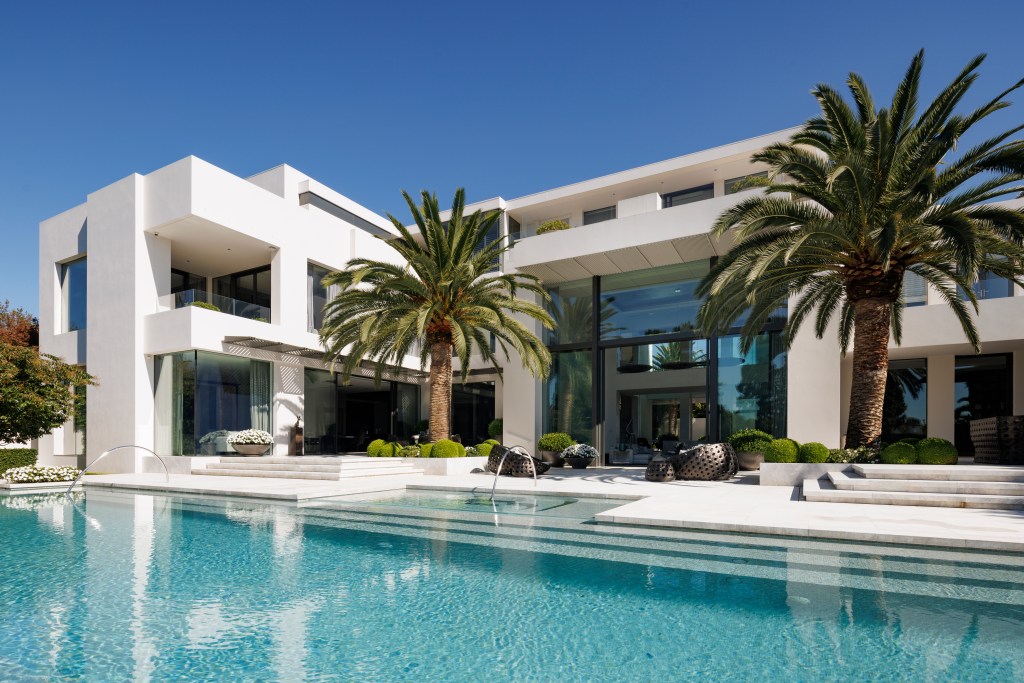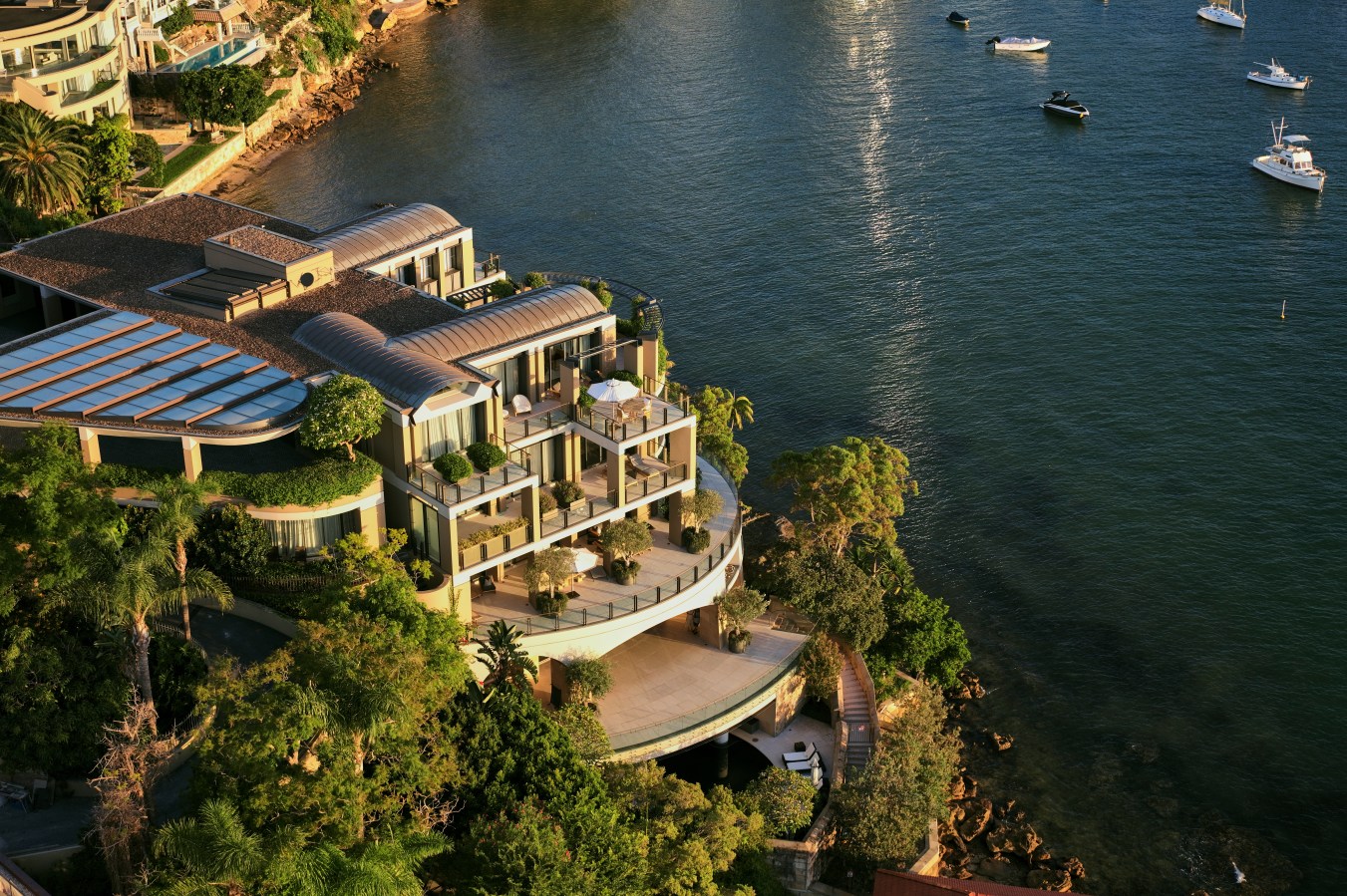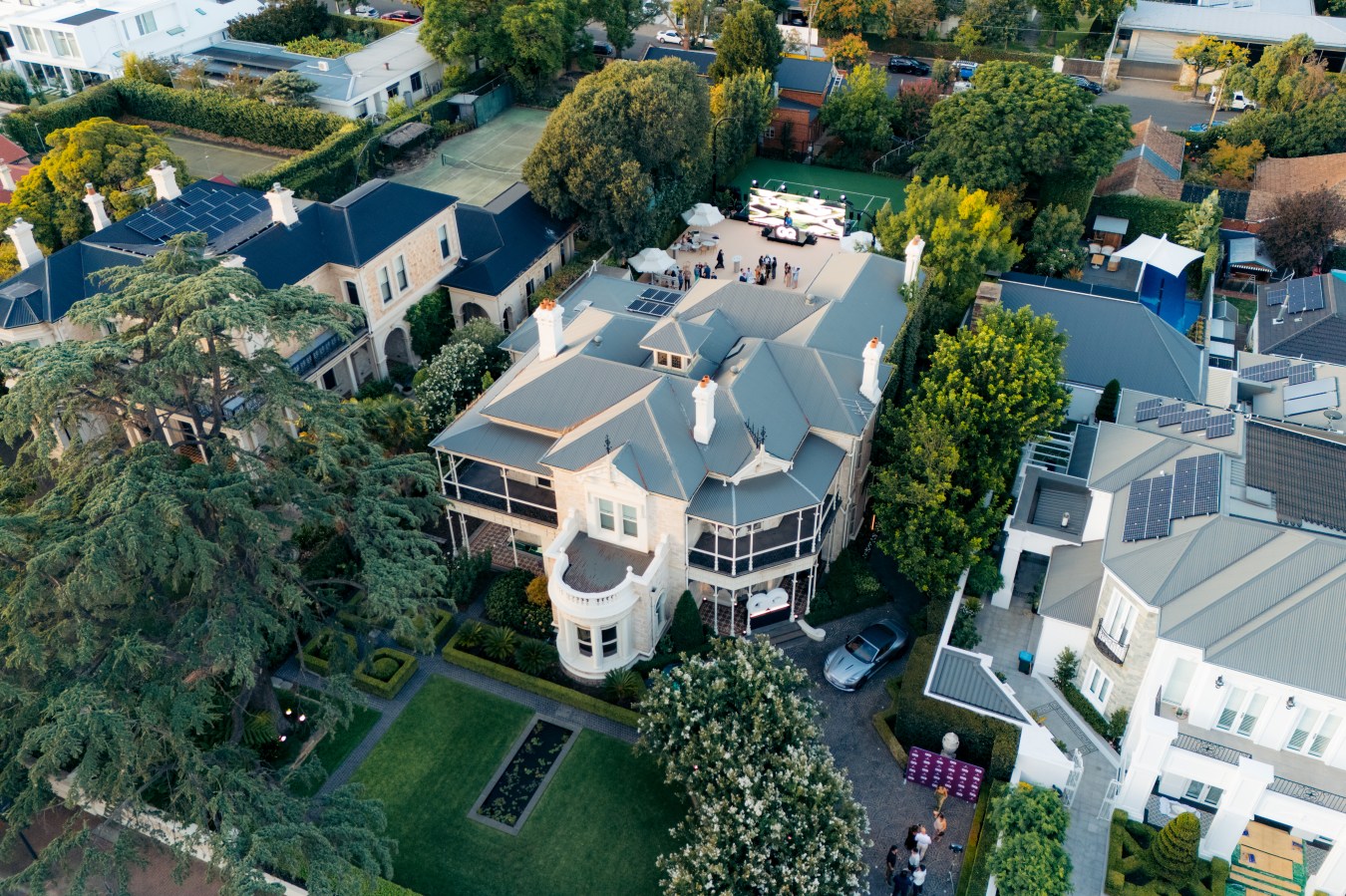There is something unassuming about architect Ilario Cortese’s residential design at the end of Macquarie Road in Toorak. But the modernist home, comprised of varying shapes faced with glass, also possesses a dignified elegance. Therein lies Cortese’s genius: architecture with a presence that also recedes, allowing the interior design, gardens, and other elements to convey the home’s essence.

“I don’t claim to be minimalist in any way, because that takes the soul out of architecture,” Cortese says. “I prefer things that are very simple and very elegant rather than a design that shouts at people. The only thing that’s important in any form of architecture is light.”
There is plenty of that in the 2,000 square-meter (21,527 square feet) home that Cortese completed in 2018. Clients John and Sue Lord were “quite liberal” in giving him free rein in the design, and “there was no budget” he says of the five-year build. “But they did frown on anything that was of a period style.”
Matching Cortese’s expertise, Paul Bangay, Australia’s foremost garden designer, mastered the home’s landscaping, and Andrew Parr, one of the country’s leading interior designers, created the quietly elegant interiors.
The downsizing owners are selling their six-bedroom three-story home for AU$80.7 million, a price that, if banked, would just top the Melbourne sales record of AU$80 million. Sue Lord is a former fashion executive and John Lord is the chairman of Neota, a business process automation platform. Realtors Michael Gibson and Robert Fletcher of Private Property Global hold the listing.

The L-shaped home has three levels atop a 500 square-meter basement (5,382 square-feet), which includes an eight-car garage, an eight-seat theatre, a temperature-controlled wine cellar, a gym with a steam room, an art studio that can be repurposed, and a room outfitted with an X-Golf simulator. A solar array covers the whole roof.
Located at the end of a cul-de-sac, the resort-like home, clad in cement render with a smooth acrylic finish, rises behind a wall set with a portico, its raised platform appearing to float.
After being buzzed in, the true show begins. A spacious courtyard is flanked with regal Canary Island date palms and shade trees. Contrasting with the home’s smooth white surface, the courtyard is paved with imported rough stone—“dark gray, and set as baguettes, long skinny lines of stone,” Cortese says. “It’s absolutely lovely paving. An incredible amount of labor went into laying the stone.”

Proceeding, an ample front door built of steel and finished in platinum leaf is set within a glass wall. Motorized, it swings open to reveal a “series of events” in which the home gradually reveals itself, says Cortese, who founded Camberwell-based Ilario G. Cortese Architects in 1989.
Entering the home, the great room’s ceilings soar two stories; walls of glass infuse the space with light. The view travels straight ahead to a courtyard and pool that fronts a tennis court.
Related
Just beyond the entry, a lower ceiling bisects the room—the underside of a north-to-south gallery, a bridge-like structure that spans the home.
Rather than interrupting the vast space, it serves to define it, lightly delineating the great room and its seductive views, while also adding interest.

A curved staircase is located to the right upon entering, its nickel balustrade comprised of interlocking oval shapes that lend an airy look. An elevator that services all floors is adjacent to the staircase.
The shorter leg of the home’s L-shaped structure is positioned to the right of the great room; it houses informal living areas and the kitchen. “We placed that section facing north so it receives the maximum amount of sun throughout the day,” Cortese says.
As with other walls of glass, the material is double glazed, which “lets in all the light, but with minimal to no thermal gain,” he adds. External shading also helps to pare summer heat.

The informal living room includes a view of two lush Canary Island date palms set on the pool’s courtyard, a match to the pair in the front.
Six more mature palms border the tennis court and groupings of trees front the pool. Banks of gardenia and jasmine edge exterior dining and lounge areas.
“Rarely do you get to create a garden for a true garden lover, and even rarer do you create one wrapped around an iconic piece of architecture,” says master gardener designer Paul Bangay whose creation echoes the owners’ preference for clean, contemporary lines while at once lushly softening the structure.
Bangay’s landscape prowess has been sought after by such dominant Australian family dynasties as the Ballieus, Myers, Packers and the Murdochs.

From inside, Bangay’s inviting gardens are framed by wall windows set in gunmetal gray aluminum. Floors are of Italian marble, and walls are finished in hand-troweled Venetian plaster.
A divider wall that’s open on both sides separates a sitting room and dining room. A double-sided fireplace sits at the wall’s base (there are also two fireplaces in the great room). The sitting room’s dramatic two-story height is filled out with a hand-blown Murano glass chandelier, its delicate circular disks seemingly floating in space.
The dining room and primary suite ceilings are finished in platinum leaf, mirroring the front door.

The chef’s kitchen with butler pantry is located behind the dining room. It harbors a curious but highly practical feature: a glass enclosure with a cooking stove and extraction fans that can be sealed off. “I haven’t done anything like it before,” Cortese says. “It enables all the smells to be held within that space.” A black granite island anchors the kitchen.
A study is located just off the kitchen, and there’s another at the opposite end of the house, adjacent to a library.
Up a floor, there are four large ensuite bedrooms each with dressing rooms. One of the bedrooms was originally planned as the primary suite before the third floor was envisioned part way into the build; the original design was for a two-story home. The bedroom’s bath features “a wall of the most beautiful mosaic, real mother of pearl,” Cortese says. “It’s the most unbelievably beautiful textural color wall that I’ve seen. It’s really quite special.”

The top floor’s primary bath also features a standout gray-blue mosaic done in a swirled pattern, created and assembled in Italy.
Parr, with Sue Lord’s input, envisioned that and other interior elements. “Andrew is sublime in how he puts things together,” Cortese says. “Nothing is dramatic and everything is just beautifully comfortably subtle.” Parr is Managing Director of Interior Design at SJB, which has offices in Sydney and Melbourne.
Parr and Lord chose silver silk carpets to cover some floors with “pile so fine that it goes in every which direction,” Cortese says. “It has a really beautiful texture, and it’s so soft.”

The primary suite and large dressing room occupies the top floor, with a rooftop terrace that affords a 180-degree view. “It probably has the best views in that area,” Cortese says. “You can see all the way to the Dandenongs,” a range of hills. A fireplace and spa is set on the terrace. “The spa looks like a square fishbowl—you can see through it,” Cortese says. “It’s an amazing piece of water sculpture when it’s lit at night.”
The Lords’ home is located in the Melbourne suburb of Toorak, a longtime haven for Australia’s wealthy industrialist families: Smorgon, Gandel, Fox, Pratt, Lew, and Meyer, among others. The neighborhood, with a population of about 12,000, has wide leafy streets and is lined by generational estates with a mix of traditional and increasingly modern styles.

“We tend to find homes in Toorak that are much older than this,” says Realtor Michael Gibson of his listing. “So, it’s an unusual offering, a true international home with universal appeal because of the architecture. It’s a significant design in terms of its proportion, but the house never overpowers.”
Adds Cortese: “The rooms impress you but they don’t overwhelm you.”
Check out the full listing at Forbes Global Properties.



